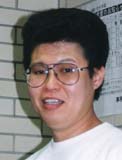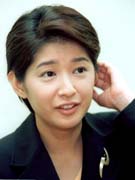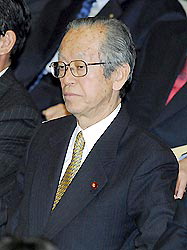Joseph Conrad’s famous novel Heart of Darkness was based on the author’s experiences in the Belgian Congo. King Leopold II of Belgium had originally wanted to establish his colony in the Philippines, but Spain refused to sell the islands to him. When the film Apocalypse Now, set in Vietnam and based on the novel Heart of Darkness, was made they filmed it in the Philippines.
Month: February 2007
LDP Relying on Washed-up Celebrities to Lure Upper House Voters — Hiromi Go, bosozoku-turned-teacher
According to ZAKZAK, singer Hiromi Go is considering a run for the Upper House on the LDP’s proportional representation ticket in the election this July. Some may remember him as the man behind a crappy Japanese version of Ricky Martin’s “La Vida Loca” that was inexplicably retitled “Goldfinger 99.” Watch:
As the resident gaijin in my high school, I was often called upon to sing the original version of this song and the Backstreet Boys’ “I Want it That Way” when I was an exchange student. I’m against Go’s candidacy if only for the fact that it forces me to remember this song. But he was most popular in the 80s, making him most attractive to middle aged female voters. One hit you can listen to is 1984’s “240 Million Eyes” (a reference to Japan’s population size, covered here by Country Musume).
 In a follow-up article to this important developing story, ZAKZAK reported that Go would be taking a major paycut if he ends up getting elected. The tone of this particular article, however, makes me think the sources are generally against him running, possibly from his talent agency. For one thing, they mention that Go would be much busier with committee meetings, hearings, and meetings with his faction. I kind of doubt he’ll be busier as a Diet member — I mean all a celebrity candidate from the proportional representation ranks has to do is keep his seat warm and vote the way the party wants him to, right? Example: Shinobu Kandori, the veteran female pro wrestler who replaced Heizo Takenaka, doesn’t seem to be doing much except for making the odd election appearance and installing a Shinto altar in her office.
In a follow-up article to this important developing story, ZAKZAK reported that Go would be taking a major paycut if he ends up getting elected. The tone of this particular article, however, makes me think the sources are generally against him running, possibly from his talent agency. For one thing, they mention that Go would be much busier with committee meetings, hearings, and meetings with his faction. I kind of doubt he’ll be busier as a Diet member — I mean all a celebrity candidate from the proportional representation ranks has to do is keep his seat warm and vote the way the party wants him to, right? Example: Shinobu Kandori, the veteran female pro wrestler who replaced Heizo Takenaka, doesn’t seem to be doing much except for making the odd election appearance and installing a Shinto altar in her office.
Other possible candidates on the LDP ticket:

Muneo:


So far, at least as far as ZAKZAK has told me, this is the best the LDP can do for famous candidates. Already megastar idol Norika Fujiwara and former NHK newscaster Midori Miyazaki have turned down spots on the ticket.
Bike parking [Photo]
Highlights from the Diet — Lower House Finance Committee, Feb 12-16 2007
Not even 3 weeks into the new Diet Session, and the Asahi has already dismissed the Diet debate as “disappointing.” I don’t know which debates they’re watching. Sure, the DPJ has elected to try and deflect attention away from the political fund scandal (since party president Ozawa has the same problem), but so far I’ve seen lots of interesting stuff:
Lower House Budget Comittee:
1. Kokumin Shinto president (and ousted LDP heavy) Shizuka Kamei made a flamboyant splash onto the scene with his first appearance asking questions in this committee in 6 years, this time as an opposition member. Though he “never in his wildest dreams thought” he would be questioning Shinzo Abe from the opposition, he went on to praise the PM as someone with good policies — if only he’d express them (here he is talking about the more hawkish attitudes Abe was famous for before he gained the premiership – strong rhetoric about territorial disputes etc). He pleaded with Abe to back away from Koizumi style winner take all politics (such as economic reforms that supposedly work for America’s national interest) and work to really make Japan better. But the most explosive of his comments came when he started questioning Abe on the appropriateness of the relationship between the LDP and its coalition partner, the Soka Gakkai-backed Komeito. Though he said he has nothing against “new religions,” even saying that both he and Abe have enjoyed the benefits of spiritual guidance, he accused the LDP of providing too much electoral support to the Komeito and passing an education bill that suits Soka Gakkai’s interests. After the Komeito demanded Kamei retract his assertion that the Komeito “supports the Iraq war,” Kamei stood by it and offered to engage in a public debate with the Komeito at Tokyo Dome. “They could even mobilize all the Soka Gakkai members.” I’m praying the Komeito takes him up on the offer.
(excerpts from the exchange here, video excerpt here)
2. The Socialist Democratic Party’s Nobuto Hosaka is closely pursuing the facts on a scandal involving improprieties over government-sponsored events (including faked town meetings), the management for most of which was contracted out to advertising giant Dentsu. At the Feb 14 meeting of the committee Hosaka questioned Supreme Court officials about the facts involving the recent incident in which people were paid to attend public forums on the Supreme Court’s new lay judge system (more info on the triangle of shadiness here). It turns out that the Supreme Court had very likely assigned Dentsu and others involved to begin promotion of the events before a contract had been signed between the government and Dentsu, the contractor charged with managing the events. How does Hosaka know this? After reviewing materials that he requested from the Supreme Court, he found that the contracts and estimates with Dentsu for all the events was dated the day before the kickoff even in Fukuoka. If there had been no agreement between Dentsu and the government before then, that would have given Dentsu less than 24 hours to pick regional newspapers to subcontract the management/promotion of the events, and then book venues/panelists, attract participants. But of course that’s not what happened. Promotional posters for the events were on bulletin boards long before that, the venues were booked ahead of time, and the attendance was healthy throughout (thanks to “gratitude payments”). Even more suspicious, the amounts charged in the invoices submitted by Dentsu to the government are identical to the amounts listed in the contracts and estimates.
All this despite the fact that (on paper at least) Dentsu was selected to manage the events after winning a “project competition,” which is a way for the government to add a form of competition to the awarding of no-bid contracts while avoiding the cumbersome government procurement process. Hosaka alleges that the dates on these contracts/estimates are fraudulent and created as an afterthough (a “sakanobori keiyaku” or “backdated contract”). This practice was typical of the fraudulent town meetings as well, Hosaka notes, and is in violation of the Public Account Law.
3. Prime Minister Abe isn’t a big fan of the New York Times. During a back and forth with the premier, DPJ member Arai quoted a recent NYT piece authored by Norimitsu Onishi that gave some sympathetic coverage of the recently bankrupted town of Yubari in Hokkaido prefecture. Arai was trying to argue that the national government needs to take more responsibility over the city’s bankruptcy (it is currently insisting that the town drastically restructure to pay off its bond obligations). Abe called the piece “insufficiently researched” because it neglected to note that the Yubari government hid its dire financial situation improperly and even gave city officials bigger bonuses in the year before the situation came to light. No press coverage of this exchange yet that I have seen.
 4. Finance Minister Koji Omi got slammed by Sumio Mabuchi (DPJ) over a slightly scandalous situation: Omi’s daughter accompanied the minister at meetings that he attended as an observer to establish his pet project, the Okinawa Institute for Science and Technology. Omi explained that she was there to help interpret the meetings and that she received no payment for her attendance. However, the problem with this, according to Mabuchi, is that a) Part of her hotel expenses as well as fees for meals and receptions were paid for with public funds, and b) If he really needs a translator he should hire a professional.
4. Finance Minister Koji Omi got slammed by Sumio Mabuchi (DPJ) over a slightly scandalous situation: Omi’s daughter accompanied the minister at meetings that he attended as an observer to establish his pet project, the Okinawa Institute for Science and Technology. Omi explained that she was there to help interpret the meetings and that she received no payment for her attendance. However, the problem with this, according to Mabuchi, is that a) Part of her hotel expenses as well as fees for meals and receptions were paid for with public funds, and b) If he really needs a translator he should hire a professional.
Now, this might not sound like a big deal, but I found Omi’s reaction to be pretty interesting. First of all, his primary excuse for bringing his daughter was one of the classic linguistic copouts: he claimed that his “hearing” abilities weren’t up to snuff, and since the meetings were all conducted in English, he brought his capable daughter along to help. This is despite his reputation for having “perfect English” at least according to US Treasury Secretary Henry Paulson. Second, Omi felt that Mabuchi was being “rude” for insinuating that Omi was being shady when he’s been working “with great ambition” to make this project happen for the good of the country. Working for the good of the country is one thing, using your status and public funds to take your daughter on a business trip to meet influential people is quite another. (Stories on this topic: Asahi, Yomiuri, Mainichi, quotes from the exchange via TBS here).
Why does Japan (and Taiwan) offer scholarships to foreigners?
In a previous discussion thread, commenter Riko of Taiwan asked me why Japan offers scholarships to foreigners. For those unfamiliar with the program, Japan’s Ministry of Education offers a number of scholarships, primarily graduate level, to foreign students from around the world, to come and study in Japan. To read about the types of scholarships avaliable, see any Japan Embassy web site and look under Education or Scholarships, for example the New York regional one (my home region). I originally types my comments below in reponse to Riko’s question, but then thought that this topic would be better as a new discussion, so here we are.
I don’t know anything about the history of the program or what the officially stated purpose is. In most Asian countries applications for the scholarships are very competitive, but people who study Japanese to a high enough level in the US are quite rare, so there are far fewer applicants for this program.
In fact, Taiwan has a similar program. When I was studying Chinese in Taipei, many of my classmates were in Taiwan on a government scholarship, doing language study before they actually entered their undergraduate or graduate program. The interesting thing in Taiwan is that there are actually two programs. One from the Ministry of Education, and one from the Ministry of Foreign Affairs. The latter program is open only to citizens of the few countries who have formal diplomatic relations with the Republic of China, and the MOE scholarships or for countries that don’t.
It seems to me that the goals of these scholarship programs in Japan and Taiwan are similar; their primary purpose is diplomatic, to build goodwill towards the host country. In Taiwan’s case, they are obviously overshadowed by China in terms of image, and they want people to come and study there so Taiwan will have a core of foreigners helping to promote the country abroad based on their good experiences there. If you look at which foreigners are studying in Taiwan, about half are Japanese-most of whom either have relatives or ancestors that are Taiwanese or who did not want to study in China either because Taiwan’s standard of living is more similar to Japan or because they worry about anti-Japan sentiment in China making it uncomfortable to be there. Then you have another 10 or 20% who are Taiwanese-Americans or Canadians, who obviously would study in their parents or grandparents’ home instead of China. Then there are a few percent who wanted to study in Taiwan because the traditional writing appealed more to them or they have family working in Taiwan or their Taiwanese friends back home suggested they go to Taiwan, but I think 20-30% or so are there because of the scholarships. If the Taiwanese government did not use these scholarships, they would probably have exactly zero students coming from most countries, and almost zero coming from some other countries if you do not count students that have blood links to Taiwan. I guarantee that I would have never even thought of going to Taiwan if they had not offered me a few months of free study there. Since Taiwan is, to put it mildly, in a diplomatically awkward situation, it is probably worth the money to take a few people each from many different countries around the world, and then send them home educated and friendly towards Taiwan. Larger numbers of these scholarships are also
Japan’s case is not as dramatic as Taiwan, but the reasons are similar if smaller scale. While there are people interested in Japan all over the world, there are virtually no communities of native speakers of Japanese outside of Japan, so most people who become fluent in Japanese and understand Japanese culture will have to live in Japan at some point. Since Japan is one of the world’s most expensive countries, there are very few people around the world who can afford to study there, and of course the number of people who could afford it is much lower in some poorer countries-and these are often the same countries where Japan has manufacturing or outsourcing facilities, or buys raw materials from.
There are probably other justifications for the program which I have missed, so please chime in.
Grand conspiracy
 The BBC reports that the Japanese whaling ship, the Nisshin Maru, has caught fire near Antarctica, possible at the hands of anti-whaling activists that were in pursuit of the ship. What they don’t mention is that this is the very same whaling ship used as a location in the Bjork art film Drawing Restraint 9. Coincidence? I think not. What are you trying to hide BBC and Bjork? Iceland’s reign of incomprehensible terror must be stopped!
The BBC reports that the Japanese whaling ship, the Nisshin Maru, has caught fire near Antarctica, possible at the hands of anti-whaling activists that were in pursuit of the ship. What they don’t mention is that this is the very same whaling ship used as a location in the Bjork art film Drawing Restraint 9. Coincidence? I think not. What are you trying to hide BBC and Bjork? Iceland’s reign of incomprehensible terror must be stopped!
How much does convening the Diet cost?
The Diet is a legislative body located in one awesome main building as well as several other office building and (controversial) dormitories. It consists of 722 elected public servants, their staff (publicly and privately funded), and permanent staff of the Diet (Legislation Bureau staff, the Diet Library, security, maintenance, cameramen, webmasters, etc). It must be an expensive venture.
Japanese blogger Kikko estimates that it costs about 100 million yen per day, 12 million yen per hour, 200,000 yen per minute to hold a Diet session. That would mean that all the time PM Abe spends clearing his throat is costing the Japanese public a few hundred yen every day.
The estimate, which is based on god-knows-what, comes in a post slamming the Abe administration for distributing a “predicted Q&A” to LDP members over a recent political funding scandal that contains allegedly false information. I don’t care much about the minute details of this scandal, but this little tidbit was interesting enough.
Japan’s divorce rate to jump in 2 months
Mainichi’s WaiWai comments on a topic that’s come up in the MF comments section:
Japan is sitting on a divorce time bomb, according to Shukan Jitsuwa (2/22).
Even though the country’s divorce rate, already low by Western standards, has witnessed a fall over the past few years as the number of marriages ending dropped from about 290,000 annually to around 260,000, pundits say this is only the calm before the storm.
The country is filled with, so the men’s weekly claims, “masked couples.” That is, sham marriages maintained purely and simply for cosmetic purposes.
But those keeping tabs on the situation say that revisions to the Basic Pension Law due to come into effect from April, which permits housewives to claim up to three times as much of their retiring husbands’ pension payments as they can now, is a powerful inducement to end an unhappy marriage.
I have a feeling that the media coverage of this phenomenon is also just seeing a calm before the storm.
Robot news: Elderly cyborg terminators from Cyberdyne
This report from the Nikkei scares the hell out of me:
Cyberdyne’s Wearable Robot Suit To Help Seniors
TSUKUBA, Ibaraki Pref. (Nikkei)–A wearable robot suit developed by university scientists that aids the user’s hand and leg movements may be Japan’s answer to a graying society in which a great number of people require lifestyle assistance, or so the developers hope.
The Hybrid Assistive Limb, or HAL, suit was developed by a team led by Tsukuba University professor Yoshiyuki Sankai. It is equipped with sensors that respond to the wearer’s brain signals telling muscles to move. With the legs and arms moving slightly before the user’s, the suit enables wearers to walk easily, without straining their arms or legs, and lift items weighing more than 20 kilograms. It is currently being used in trials at health care facilities specializing in the elderly.
Cyberdyne Inc., a venture set up by Tsukuba University, will team up with Daiwa House Industry Co. (1925) to produce 400 HAL suits a year. To this end, Daiwa House recently invested roughly 1 billion yen into the company through a private placement of new shares. The Tsukuba University spinoff will use the proceeds to establish a mass production infrastructure by next fall.
A “HAL” designed by “Cyberdyne.” There are two possible explanations here: 1) the developers are actually trying to help the elderly and just happen to be big fans of apocalyptic science fiction; or 2) They are diabolical madmen with a sense of irony and are raising an army of elderly cyborgs to rule the world.
Up and Down on the Abe reform agenda
Though it seems like everyone and his brother (including myself) are writing off Abe as a dishonest hack who might be replaced after the July upper house elections, not everyone sees it that way. I thought I’d take a quick look at some of my favorite opinionated pundits to see who’s up and down with Abe’s performance, particularly in the realm of the reform agenda (something we don’t hear too much about these days:
Up — Robert Feldman of Morgan Stanley:
Brilliant, Mr. Abe, Brilliant!
February 01, 2007By Robert Alan Feldman | Tokyo
Political commentary on PM Abe has been unrelentingly negative. Indeed, there seems to be a bandwagon effect, as more and more pundits jump in to criticize. Unseen by these pundits, however, is a revolutionary change in the process of government. Policy competition within the government is emerging and seems to be a permanent feature of governance. Prior to PM Koizumi’s tenure, policy areas were typically monopolies. One ministry had control of the agenda for a given area. By gentlemen’s’ agreement, other ministries did not move beyond their jurisdictions.
…
Under PM Abe, competition between the PM’s Office and the bureaucracies has become the standard. Now, from the very start, PM Abe has formed special committees of non-government experts to deal with a broad range of issues. Examples areas include labor policy, agricultural policy, education policy, innovation policy, and — most interestingly — financial sector reform policy.[1] Action in the latter area has accelerated sharply over the last few days, and points to what we can expect in other areas.
…
[Feldman then describes the series of events that have led to the formation of competing committees — one in the Council on Economic and Fiscal Policy (a cabinet advisory body intended to take initiative of the budgeting and policymaking agenda away from the bureaucrats), and one in the Financial Services Agency (who currently has jurisdiction in this area)]
…
Now that both committees exist, they will have to compete in the public eye. Both will release materials and minutes, so that investors and the public can follow the debate closely. Moreover, since PM Abe’s committee has been formed under the CEFP, the matter will have to be discussed in that committee, under his own chairmanship. Naturally, both committees take the debate seriously.The next phase of the debate is gathering opinions from the public. Both committees are eagerly seeking advice from around the world. Indeed, a friendly competition has emerged to see which committee can come up with the best plan. Expert witnesses will be called by both committees, and the press will notice.
…
Even more important could be the effect on confidence [in the market that sparked by the “intelligent policies” that Feldman is sure will result from this policy competition] in the Abe government itself. The government has already scored major wins in foreign policy, but a clear victory on reform has yet to emerge. The financial system debate is a major opportunity. The conclusion will not be far off. The PM’s own subcommittee on the issue is reportedly scheduled to submit its ideas by the end of March. The FSA committee cannot lag far behind, for fear of losing the battle.
Comment: This is very encouraging as this policymaking style is a similar of Koizumi’s smart management of reform campaigns: Take a sector that is in dire need of reform (in this case Japan’s financial markets), take up bold reform measures at the cabinet level, and then spark competition among agencies to try and work out the best policy. This is similar to Koizumi’s tactics that resulted in privatization of the highway public corporations and Japan Post — two interrelated sources of waste in the economy and a drag on public resources. Of course, “international competitiveness” for the financial sector is a relatively small issue compared to the quixotic goals of the Koizumi years.
Continue reading Up and Down on the Abe reform agenda


 Cyberdyne Inc., a venture set up by Tsukuba University, will team up with Daiwa House Industry Co. (1925) to produce 400 HAL suits a year. To this end, Daiwa House recently invested roughly 1 billion yen into the company through a private placement of new shares. The Tsukuba University spinoff will use the proceeds to establish a mass production infrastructure by next fall.
Cyberdyne Inc., a venture set up by Tsukuba University, will team up with Daiwa House Industry Co. (1925) to produce 400 HAL suits a year. To this end, Daiwa House recently invested roughly 1 billion yen into the company through a private placement of new shares. The Tsukuba University spinoff will use the proceeds to establish a mass production infrastructure by next fall.